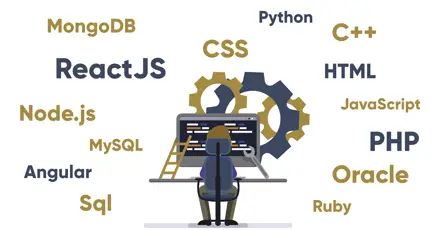What is Full Stack? Overview of Full Stack Developer
In the ever-evolving landscape of web development, the term "What is Full Stack?" has become increasingly prominent. If you've embarked on a journey into the world of web programming, you've likely encountered the intriguing concept of full-stack development.
This article by Aniday is your compass in navigating this dynamic realm. We'll unravel the mysteries surrounding full-stack development, providing insights into its definition, roles, advantages, and essential knowledge required for aspiring full-stack developers. So, let's embark on a journey to understand "What is Full Stack?" and discover the multifaceted world it encompasses.
The Definition of Full Stack

Full Stack programmers work on both the front-end and back-end. Source: Coursera
So, what is Full Stack? Full stack is a term used to describe a programmer who can work on both the front-end and back-end of a web application:
- Front-end is the user interface that displays content and functionality to users.
- Back-end handles logic, data, and interactions with other systems in a web application.
A full-stack developer is capable of designing, building, and maintaining both parts of a web application.
The Role of Full Stack Developer
Next, let's explore the role of a programmer in What is Full Stack? A full-stack developer can take on various roles in a web project based on their requirements and skills. Some common roles of a full-stack developer include:
- Designing user interfaces (UI) and user experiences (UX) for web applications using HTML, CSS, JavaScript, Bootstrap, React, Angular, Vue, and more.
- Programming logic, functions, and features for web applications using PHP, Python, Ruby, Node.js, Express, Laravel, Django, Rails, and more.
- Designing, creating, and managing databases for web applications using database management systems (DBMS) like MySQL, MongoDB, PostgreSQL, Oracle, and others.
- Deploying and operating web applications on web hosting platforms such as AWS, Azure, Heroku, Firebase, and more.
- Utilizing version control systems such as Git, SVN to manage source code and collaborate with other programmers on the team.
- Testing and resolving errors in web applications using TDD, BDD, unit testing, integration testing, and debugging tools.
Advantages and Disadvantages of the Full Stack Developer Profession

The Full Stack profession has both advantages and disadvantages. Source: Entrepreneur
Aniday will now share some advantages and disadvantages of the Full Stack profession:
Advantages
- Ability to handle various aspects of a web project, from designing interfaces to building functionality.
- Flexibility to switch between different tasks depending on project needs.
- Ease of collaboration and communication with other developers because they understand both sides of a web application.
- Capability to independently build complete web applications from start to finish.
Disadvantages
- Constant need to learn and update new knowledge and technology due to the ever-changing and developing web programming field.
- Difficulty in specializing in a particular field since full-stack developers work with many different technologies.
- Challenges in managing time and prioritizing work effectively.
Necessary Knowledge When Becoming a Full Stack Developer

To become a Full Stack Developer, you need to be equipped with industry knowledge. Source: GeeksforGeeks
To become a full-stack developer, you need a solid knowledge base of languages, tools, and techniques related to both the front-end and back-end of web applications. Aniday will share the essential knowledge needed for What is Full Stack?:
Front-end languages and frameworks
Front-end involves the user interface of a web application, where users interact directly. To develop the front-end, a full-stack programmer needs to master:
- Basic languages: HTML, CSS, and JavaScript.
- Supported libraries and frameworks: Bootstrap, jQuery, React, Angular, Vue, and more.
These languages, libraries, and frameworks enable the creation of diverse, user-friendly interfaces compatible with various devices.
Back-end technologies and frameworks
Back-end handles the background logic of a web application, managing requests from the front-end and retrieving data from databases. To develop the back-end, a full-stack programmer needs to understand:
- Popular programming languages: PHP, Python, Ruby, Java, C, Node.js.
- Associated frameworks: Laravel, Django, Rails, Spring Boot, ASP.NET, Express, and more.
These languages and frameworks facilitate the development of high-performance, secure, and maintainable web applications.
Database Management System
Databases store data for web applications, including user information, products, orders, and more. Full-stack programmers managing databases need proficiency in at least one popular database management system such as MySQL, PostgreSQL, MongoDB, Firebase, and others. These systems support the creation of stable, secure, and query-friendly databases.
Version Control
Version control is a tool for managing different versions of a web application's source code. Full-stack developers should have a good grasp of at least one popular version control system like Git, SVN, or Mercurial. These systems track changes in source code, facilitate restoration of old versions when necessary, and support effective teamwork.
Web Hosting Platforms
Web hosting platforms are services that enable the deployment of web applications on the internet for user access. Full-stack programmers need an understanding of at least one popular web hosting service such as AWS, Google Cloud Platform, Heroku, Netlify, and more. These services help create web applications with continuous uptime, high load capacity, and easy scalability.
Salary of Full Stack Developer
According to Indeed, the average salary for a full stack developer is **$6,764** per month in Singapore as of September 2023. However, this may vary depending on the level of experience, skills and company.
Fresher
A fresher is someone who has just graduated from a coding bootcamp or a degree program and has little or no work experience as a Full Stack Developer. According to Indeed, the average salary for a fresher Full Stack Developer in Singapore is $4,874 per month.
Junior
A junior is someone who has some work experience as a Full Stack Developer, usually between one to three years. According to Glassdoor, the average salary for a junior Full Stack Developer in Singapore is $6,030 per month.
Senior
A senior is someone who has extensive work experience as a Full Stack Developer, usually more than five years. According to Credit Suisse, the average salary for a senior Full Stack Developer in Singapore is $12,359 per month.
Conclusion
In a world where versatility and proficiency are paramount in the realm of web development, understanding "What is Full Stack?" becomes a key asset. This article by Aniday has ventured into the heart of Full Stack development, unraveling its intricacies, from its definition and role to the essential knowledge required and salary prospects.
Whether you're an aspiring developer embarking on this exciting journey or a business seeking dynamic talent, this knowledge equips you with the insights needed to navigate the realm of Full Stack development. Being a Full Stack developer is more than just a role; it's a testament to adaptability and expertise. We trust that this comprehensive exploration has provided you with a clear understanding of "What is Full Stack?" and its potential opportunities. Thank you for joining us on this enlightening journey.
Reference:
Salary: Full Stack Developer in Singapore, Singapore 2023 | Glassdoor
Full stack developer salary in Singapore (indeed.com)
Developer Salaries in Singapore for Credit Suisse | Indeed.co
Aniday's HR Services
Headhunting Service
Find and recruit quality candidates in just 1 week! Supported by 40,000 experienced headhunters in IT, Finance, Marketing… capable of recruiting in any region.
Headhunting Service ➔Employer of Record (EOR) Service
On behalf of your business, we recruit employees and handle payroll without the need to establish a company in markets such as Vietnam, Singapore, Malaysia, India, Indonesia…
Employer of Record (EOR) Service ➔